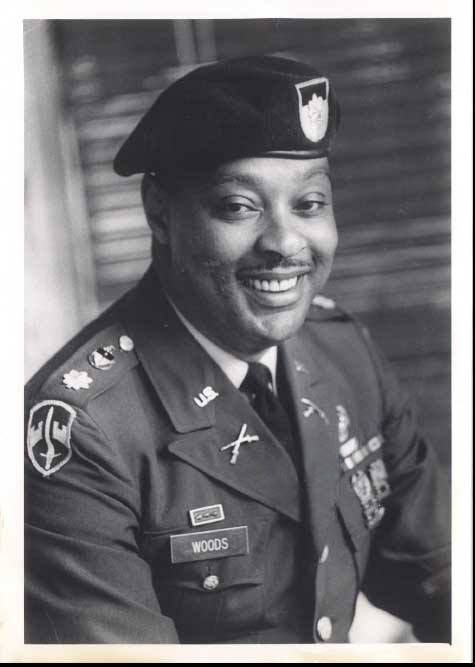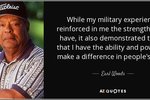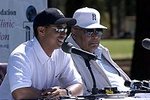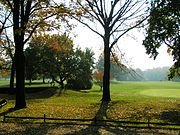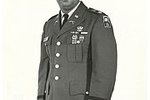22
22
0
Earl Woods
https://en.wikipedia.org/wiki/Earl_Woods
arl Dennison Woods (March 5, 1932 – May 3, 2006) was a US Army infantry officer who served two tours of duty in Vietnam and retired with the rank of lieutenant colonel. He was a college-level baseball player, writer, and father of professional golfer Tiger Woods. Woods started his son in golf at a very early age and coached him exclusively for his first years in the sport.
Woods served two combat tours during the Vietnam War, the first as an infantry officer, and the second with the elite United States Army Special Forces.[2]
After graduating from the Defense Information School and being promoted to lieutenant colonel, he was assigned as an instructor of Military Science & Tactics, (Army ROTC) at the City College of New York. He retired from active duty in 1974.[4]
Woods moved to Southern California, and became an agent for corporations in defense industry contracting.
https://en.wikipedia.org/wiki/Earl_Woods
arl Dennison Woods (March 5, 1932 – May 3, 2006) was a US Army infantry officer who served two tours of duty in Vietnam and retired with the rank of lieutenant colonel. He was a college-level baseball player, writer, and father of professional golfer Tiger Woods. Woods started his son in golf at a very early age and coached him exclusively for his first years in the sport.
Woods served two combat tours during the Vietnam War, the first as an infantry officer, and the second with the elite United States Army Special Forces.[2]
After graduating from the Defense Information School and being promoted to lieutenant colonel, he was assigned as an instructor of Military Science & Tactics, (Army ROTC) at the City College of New York. He retired from active duty in 1974.[4]
Woods moved to Southern California, and became an agent for corporations in defense industry contracting.
Edited 6 y ago
Posted 6 y ago
Responses: 6
Earl Woods talks Tiger Woods on Charlie Rose (1997) From http://www.1steptobettergolf.com. - The...
Bob Toski analyzes the golf swing of Tiger Woods. We see the Tiger's swings from various angles and in slow motion. First of all . Bob Toski analyzes the gol...
Thank you, my friend Maj Marty Hogan for making us aware that March 5 is the anniversary of the birth of college-level baseball player, US Army infantry officer who served two tours of duty in Vietnam and writer Earl Dennison Woods.
Earl Woods talks Tiger Woods on Charlie Rose (1997)
https://www.youtube.com/watch?v=hm0dBthoLg4
Images:
1. LTC Earl Dennison Woods
2. Tiger Woods with father Earl Woods and mother Kultida Woods nickname Tida born
3. Earl Woods 'while my military experience reinforced in me the strength that I have, it also demonstrated to me that I have the ability and power to make a difference in people's lives.'
4. Tiger and Earl Woods during a 2004 press conference at Fort Bragg
Background from [https://military.wikia.org/wiki/Earl_Woods]
"Earl Woods
Birth name Earl Dennison Woods
Born March 5, 1932
Died May 3, 2006 (aged 74)
Place of birth Manhattan, Kansas
Place of death Cypress, California
Buried at Manhattan, Kansas[1]
Allegiance United States
Service/branch United States Army
Years of service 1954–1974[2]
Rank Lieutenant Colonel
Unit Green Berets
Military Assistance Command, Vietnam
Battles/wars Vietnam War
Awards Bronze Star
Army Commendation Medal
Vietnam Gallantry Cross
Relations Tiger Woods
Cheyenne Woods
Earl Dennison Woods (March 5, 1932 – May 3, 2006) was a US Army infantry officer who served two tours of duty in Vietnam, and retired with the rank of lieutenant colonel. He was a college-level baseball player and writer, whose son is professional golfer Tiger Woods. Woods started his son in golf at a very early age, and coached him exclusively for his first years in the sport.
Early life
Earl Woods was born in Manhattan, Kansas. His father, Miles Woods, had five children by his first wife, Viola, and six more (of whom Earl was the youngest) by his second, Maude Carter. Miles Woods was an epileptic who worked as a street cleaner and caretaker. Although he was a devout Baptist, he also had a reputation for being able to swear for 30 minutes without interruption. Earl Woods once remarked, "I picked up on that". Earl Woods' mother, Maude (Carter) Woods, was of mixed African and European ancestry. Woods' siblings ranged from fairly dark to very light; he remembered that his grandmother Carter, a Mulatto, was "the prettiest blonde you ever saw." There was a family joke about an alleged Chinese ancestor who "didn't stay on his railroad job," but there is no record of any Chinese ancestry. However, the family is said to have some Native American ancestry.[3] Miles Woods loved baseball and passed his passion on to his son. Maude Woods, who was college educated, was determined her children should make the best of themselves. When her husband died in 1943, however, she had to go to work as a maid. Earl Woods recalled that it "broke her heart". Woods' mother died when he was 15, and he was raised from then on by his older sister Hattie Bell Woods.
College, sports, segregation
Earl Woods attended Kansas State University (then known as Kansas State College), and played baseball, earning a varsity letter in both 1952 and 1953.
His teammate Larry Hartshorn recalled how Woods once was not allowed to play at a college in Mississippi because of his race. The entire Kansas State baseball team refused to play and left in protest.[1]
Woods broke the Big Eight Conference (then the Big Seven Conference) "color barrier" in baseball in 1951.[4] He usually played as a catcher, and was offered a contract by the Kansas City Monarchs of the Negro Leagues. However, he decided to continue his education, graduated in 1953 with a B.S. in Sociology,[5] and was commissioned an officer in the U.S. Army.[1]
ilitary career
Woods served two combat tours during the Vietnam War, the first as an infantry officer, and the second with the elite United States Army Special Forces.[2]
After graduating from the Defense Information School and being promoted to lieutenant colonel, he was assigned as an instructor of Military Science & Tactics, (Army ROTC) at the City College of New York. He retired from active duty in 1974.[4]
Woods moved to southern California, and became an agent for corporations in defense industry contracting.
Personal life
Woods married Barbara Gary on May 18, 1954, in Abilene, Kansas.[5] They had three children: Earl Dennison Jr. (1955), Kevin Dale (1957), and Royce Renee (1961).[6] Earl Jr.'s daughter Cheyenne Woods is also a competitive golfer and received some coaching from Earl Sr.
Woods and his wife divorced in 1968 in Ciudad Juárez, Mexico.[7]
Woods had met his second wife, Kultida Punsawad, while stationed in Thailand in 1966.[8] Punsawad is half Thai, a quarter Dutch and a quarter Chinese. They married in 1969 in Brooklyn, New York. Their son Eldrick was born in 1975. His son's nickname, "Tiger," comes from Earl Woods' wartime friendship with Colonel Vuong Dang "Tiger" Phong, a courageous pilot who flew in the Vietnamese Army.
Teaching his son to golf
In 1972, Woods was stationed at Brooklyn's Fort Hamilton, and learned to play golf, starting at age 42,[4] at the Dyker Beach Golf Course in Dyker Heights.[9][10][11] From his first experience with golf, Earl Woods was captivated by it, and played a great deal for the remainder of his life. He eventually became a good standard amateur golfer, often scoring in the 70s for 18 holes. Earl claimed to be playing close to scratch handicap level when Tiger was born in late 1975.[4] Coached by his father, Tiger Woods was introduced to golf in Orange County, California before age two, and became a child prodigy in golf, perhaps the most precocious young golfer in history. Tiger learned golf first on the U.S. military courses in southern California.[4]
Books
Earl Woods shared the techniques he used in coaching his son Tiger in two books: Training a Tiger: A Father's Guide to Raising a Winner in Both Golf and Life, and Playing Through: Straight Talk on Hard Work, Big Dreams and Adventures with Tiger. Woods coached Tiger exclusively until age five, then sought professional assistance from Rudy Duran and John Anselmo, both well-regarded PGA club professionals in the area.[4][7] Earl Woods has been criticized by some for putting too much pressure on Tiger. In 1993, following Tiger's third straight title in the USGA Junior Amateur Championship, Earl Woods sought out superstar teacher Butch Harmon to develop Tiger's game to the next level.[4][7][12] Harmon, upon meeting Tiger Woods for the first time in Houston in summer 1993, praised the coaching which Earl Woods, Duran, and Anselmo had done to that stage.[12]
Tiger's career
Tiger and Earl Woods during a 2004 press conference at Fort Bragg
Earl Woods retired from his second career in 1988. He traveled to Tiger's events as often as possible for the rest of his life. Earl Woods hired Connecticut attorney John Merchant in 1996 to help facilitate the path for Tiger to turn professional, and to secure lucrative sponsorship agreements when he did so. Merchant had been the first African American member of the United States Golf Association's Executive Committee. Tiger signed deals with Nike, Titleist, and the International Management Group, which made him a multi-millionaire as soon as he declared professional status, in late August 1996. Tiger's deals broke by a wide margin all records for sponsorship money in golf. Soon after Tiger turned professional, Merchant was fired by Earl Woods.[13]
Death
Earl Woods was diagnosed with prostate cancer in 1998. He survived it, but died from a heart attack at his home in Cypress, California in 2006 at the age of 74. He was buried at Sunset Cemetery in Manhattan, Kansas.
Memorials
The Earl Woods National Youth Golf Academy at Colbert Hills Golf Course in Manhattan, Kansas is named in his honor. It was host to the first First Tee National Academy in 2000.
Nike commercial
On April 8, 2010, Nike released a television commercial, created by the Wieden + Kennedy ad agency, featuring the somber face of Tiger Woods (depicted in black and white) and the voice of Earl Woods. The audio track of the commercial was taken from a 2004 interview of Earl for the documentary DVD Tiger: The Authorized DVD Collection,[14] in which Earl discussed comparing the "authoritative" nature of his wife, Kultida, to his own "inquisitive" nature. The commercial utilized a sound bite from that interview as a backdrop to the camera capture of Tiger's face, and it was widely interpreted as a skewing of Earl's words to posthumously address Tiger's own marital issues which had recently come to light; the commercial was released on the same day that Tiger had made his anticipated return to competition at the Masters Tournament following a five-month self-imposed absence during the resulting public fallout, and it was the first commercial to feature Tiger's participation since the scandal first breached public scrutiny.
Reactions to the commercial varied widely,[15] with criticisms being particularly leveled at Nike for utilizing Tiger's own domestic issues for commercial gain and plaudits being forwarded to Tiger for addressing how the scandal had affected him both in private and public life.
Notes
1. ↑ 1.0 1.1 1.2 Tramel, Jimmie (August 3, 2007). "Tulsa World: Tiger was raised by a Wildcat". Tulsa World. Archived from the original on February 17, 2009. http://web.archive.org/web/ [login to see] 3439/http://www.tulsaworld.com/sports/article.aspx?articleID=070803_2_B1_hPlay11047. Retrieved July 6, 2009.
2. ↑ 2.0 2.1 "Earl Woods" (Fee, via Fairfax County Public Library). Contemporary Authors Online. Detroit: Gale. 2006. GALE|H [login to see] . http://ic.galegroup.com/ic/bic1/ReferenceDetailsPage/ReferenceDetailsWindow?displayGroupName=Reference&disableHighlighting=false&prodId=BIC1&action=e&windowstate=normal&catId=&documentId=GALE%7CH [login to see] &mode=view&userGroupName=fairfax_main&jsid=a2bc0eff7991ec09a35257dff96d1bef. Retrieved February 29, 2012. Gale Biography In Context. (subscription required)
3. ↑ "Earl Woods". May 5, 2006. http://www.telegraph.co.uk/news/obituaries/1517444/Earl-Woods.html. Retrieved February 29, 2012.
4. ↑ 4.0 4.1 4.2 4.3 4.4 4.5 4.6 Woods, Earl; McDaniel, Pete (1997). Training a Tiger: A Father's Guide to Raising a Winner in Both Golf and Life. HarperCollins. ISBN 978-0-06-270178-7.
5. ↑ 5.0 5.1 Sounes, p. 35
6. ↑ Sounes, p. 114
7. ↑ 7.0 7.1 7.2 Sounes, Howard (2004). The Wicked Game: Arnold Palmer, Jack Nicklaus, Tiger Woods, and the story of modern golf (illustrated ed.). HarperCollins. pp. 116 et seq. ISBN 978-0-06-051386-3. http://books.google.com/books?id=2BgpTxQzrGoC&dq=Howard+Sounes,+The+Wicked+Game&printsec=frontcover&source=bl&ots=9kLMzEW55k&sig=faBVZicaC_rzuN0c9r2N9n0kaUg&hl=en&ei=BfRRSprwCsKvtweo9PivBA&sa=X&oi=book_result&ct=result&resnum=1. Retrieved July 6, 2009.
8. ↑ Sounes, p. 115.
9. ↑ Tennenbaum, Raphael (August/September 2007). "Golf and the City - The City Game After years of neglect and despite numerous obstacles, public golf courses in New York City are alive and well" (PDF). The Met Golfer. http://www.ray-field.com/Golf_and_the_City.pdf.
10. ↑ Firger, Jessica (June 14, 2008). "Fore free! Dyker junior links open". http://www.brooklynpaper.com/stories/31/24/31_24_fore_free_dyker_junior.html. Retrieved March 1, 2012.
11. ↑ Dyker Beach Park – A Golf Course Just For Kids NYC Parks Department
12. ↑ 12.0 12.1 Harmon, Butch (2007). The Pro: Lessons About Golf and Life from My Father, Claude Harmon, Sr.. Three Rivers Press. ISBN 978-0-307-33804-4.
13. ↑ Sounes, pp. 175–95.
14. ↑ Tiger Woods Ad Ripped Audio from 2004 Documentary, by Russell Goldman, April 8, 2010, ABC News
15. ↑ O'Neal Parker, Lonnae (April 8, 2010). "Mixed reaction to Nike ad with Tiger Woods, his dad's voice". http://www.washingtonpost.com/wp-dyn/content/article/2010/04/08/AR [login to see] 525.html?hpid=topnews.
FYI LTC John Shaw LTC John Griscom LTC Ivan Raiklin, Esq. Maj Robert Thornton SFC (Join to see) SGT Steve McFarland MSG Andrew White Maj Bill Smith, Ph.D.COL Mikel J. Burroughs SMSgt Lawrence McCarterSGT (Join to see) CWO3 (Join to see) PO1 William "Chip" Nagel LTC (Join to see)SPC Matthew LambSSG Robert "Rob" WentworthSSG William JonesPO1 Robert GeorgeSSG Robert Mark Odom
Earl Woods talks Tiger Woods on Charlie Rose (1997)
https://www.youtube.com/watch?v=hm0dBthoLg4
Images:
1. LTC Earl Dennison Woods
2. Tiger Woods with father Earl Woods and mother Kultida Woods nickname Tida born
3. Earl Woods 'while my military experience reinforced in me the strength that I have, it also demonstrated to me that I have the ability and power to make a difference in people's lives.'
4. Tiger and Earl Woods during a 2004 press conference at Fort Bragg
Background from [https://military.wikia.org/wiki/Earl_Woods]
"Earl Woods
Birth name Earl Dennison Woods
Born March 5, 1932
Died May 3, 2006 (aged 74)
Place of birth Manhattan, Kansas
Place of death Cypress, California
Buried at Manhattan, Kansas[1]
Allegiance United States
Service/branch United States Army
Years of service 1954–1974[2]
Rank Lieutenant Colonel
Unit Green Berets
Military Assistance Command, Vietnam
Battles/wars Vietnam War
Awards Bronze Star
Army Commendation Medal
Vietnam Gallantry Cross
Relations Tiger Woods
Cheyenne Woods
Earl Dennison Woods (March 5, 1932 – May 3, 2006) was a US Army infantry officer who served two tours of duty in Vietnam, and retired with the rank of lieutenant colonel. He was a college-level baseball player and writer, whose son is professional golfer Tiger Woods. Woods started his son in golf at a very early age, and coached him exclusively for his first years in the sport.
Early life
Earl Woods was born in Manhattan, Kansas. His father, Miles Woods, had five children by his first wife, Viola, and six more (of whom Earl was the youngest) by his second, Maude Carter. Miles Woods was an epileptic who worked as a street cleaner and caretaker. Although he was a devout Baptist, he also had a reputation for being able to swear for 30 minutes without interruption. Earl Woods once remarked, "I picked up on that". Earl Woods' mother, Maude (Carter) Woods, was of mixed African and European ancestry. Woods' siblings ranged from fairly dark to very light; he remembered that his grandmother Carter, a Mulatto, was "the prettiest blonde you ever saw." There was a family joke about an alleged Chinese ancestor who "didn't stay on his railroad job," but there is no record of any Chinese ancestry. However, the family is said to have some Native American ancestry.[3] Miles Woods loved baseball and passed his passion on to his son. Maude Woods, who was college educated, was determined her children should make the best of themselves. When her husband died in 1943, however, she had to go to work as a maid. Earl Woods recalled that it "broke her heart". Woods' mother died when he was 15, and he was raised from then on by his older sister Hattie Bell Woods.
College, sports, segregation
Earl Woods attended Kansas State University (then known as Kansas State College), and played baseball, earning a varsity letter in both 1952 and 1953.
His teammate Larry Hartshorn recalled how Woods once was not allowed to play at a college in Mississippi because of his race. The entire Kansas State baseball team refused to play and left in protest.[1]
Woods broke the Big Eight Conference (then the Big Seven Conference) "color barrier" in baseball in 1951.[4] He usually played as a catcher, and was offered a contract by the Kansas City Monarchs of the Negro Leagues. However, he decided to continue his education, graduated in 1953 with a B.S. in Sociology,[5] and was commissioned an officer in the U.S. Army.[1]
ilitary career
Woods served two combat tours during the Vietnam War, the first as an infantry officer, and the second with the elite United States Army Special Forces.[2]
After graduating from the Defense Information School and being promoted to lieutenant colonel, he was assigned as an instructor of Military Science & Tactics, (Army ROTC) at the City College of New York. He retired from active duty in 1974.[4]
Woods moved to southern California, and became an agent for corporations in defense industry contracting.
Personal life
Woods married Barbara Gary on May 18, 1954, in Abilene, Kansas.[5] They had three children: Earl Dennison Jr. (1955), Kevin Dale (1957), and Royce Renee (1961).[6] Earl Jr.'s daughter Cheyenne Woods is also a competitive golfer and received some coaching from Earl Sr.
Woods and his wife divorced in 1968 in Ciudad Juárez, Mexico.[7]
Woods had met his second wife, Kultida Punsawad, while stationed in Thailand in 1966.[8] Punsawad is half Thai, a quarter Dutch and a quarter Chinese. They married in 1969 in Brooklyn, New York. Their son Eldrick was born in 1975. His son's nickname, "Tiger," comes from Earl Woods' wartime friendship with Colonel Vuong Dang "Tiger" Phong, a courageous pilot who flew in the Vietnamese Army.
Teaching his son to golf
In 1972, Woods was stationed at Brooklyn's Fort Hamilton, and learned to play golf, starting at age 42,[4] at the Dyker Beach Golf Course in Dyker Heights.[9][10][11] From his first experience with golf, Earl Woods was captivated by it, and played a great deal for the remainder of his life. He eventually became a good standard amateur golfer, often scoring in the 70s for 18 holes. Earl claimed to be playing close to scratch handicap level when Tiger was born in late 1975.[4] Coached by his father, Tiger Woods was introduced to golf in Orange County, California before age two, and became a child prodigy in golf, perhaps the most precocious young golfer in history. Tiger learned golf first on the U.S. military courses in southern California.[4]
Books
Earl Woods shared the techniques he used in coaching his son Tiger in two books: Training a Tiger: A Father's Guide to Raising a Winner in Both Golf and Life, and Playing Through: Straight Talk on Hard Work, Big Dreams and Adventures with Tiger. Woods coached Tiger exclusively until age five, then sought professional assistance from Rudy Duran and John Anselmo, both well-regarded PGA club professionals in the area.[4][7] Earl Woods has been criticized by some for putting too much pressure on Tiger. In 1993, following Tiger's third straight title in the USGA Junior Amateur Championship, Earl Woods sought out superstar teacher Butch Harmon to develop Tiger's game to the next level.[4][7][12] Harmon, upon meeting Tiger Woods for the first time in Houston in summer 1993, praised the coaching which Earl Woods, Duran, and Anselmo had done to that stage.[12]
Tiger's career
Tiger and Earl Woods during a 2004 press conference at Fort Bragg
Earl Woods retired from his second career in 1988. He traveled to Tiger's events as often as possible for the rest of his life. Earl Woods hired Connecticut attorney John Merchant in 1996 to help facilitate the path for Tiger to turn professional, and to secure lucrative sponsorship agreements when he did so. Merchant had been the first African American member of the United States Golf Association's Executive Committee. Tiger signed deals with Nike, Titleist, and the International Management Group, which made him a multi-millionaire as soon as he declared professional status, in late August 1996. Tiger's deals broke by a wide margin all records for sponsorship money in golf. Soon after Tiger turned professional, Merchant was fired by Earl Woods.[13]
Death
Earl Woods was diagnosed with prostate cancer in 1998. He survived it, but died from a heart attack at his home in Cypress, California in 2006 at the age of 74. He was buried at Sunset Cemetery in Manhattan, Kansas.
Memorials
The Earl Woods National Youth Golf Academy at Colbert Hills Golf Course in Manhattan, Kansas is named in his honor. It was host to the first First Tee National Academy in 2000.
Nike commercial
On April 8, 2010, Nike released a television commercial, created by the Wieden + Kennedy ad agency, featuring the somber face of Tiger Woods (depicted in black and white) and the voice of Earl Woods. The audio track of the commercial was taken from a 2004 interview of Earl for the documentary DVD Tiger: The Authorized DVD Collection,[14] in which Earl discussed comparing the "authoritative" nature of his wife, Kultida, to his own "inquisitive" nature. The commercial utilized a sound bite from that interview as a backdrop to the camera capture of Tiger's face, and it was widely interpreted as a skewing of Earl's words to posthumously address Tiger's own marital issues which had recently come to light; the commercial was released on the same day that Tiger had made his anticipated return to competition at the Masters Tournament following a five-month self-imposed absence during the resulting public fallout, and it was the first commercial to feature Tiger's participation since the scandal first breached public scrutiny.
Reactions to the commercial varied widely,[15] with criticisms being particularly leveled at Nike for utilizing Tiger's own domestic issues for commercial gain and plaudits being forwarded to Tiger for addressing how the scandal had affected him both in private and public life.
Notes
1. ↑ 1.0 1.1 1.2 Tramel, Jimmie (August 3, 2007). "Tulsa World: Tiger was raised by a Wildcat". Tulsa World. Archived from the original on February 17, 2009. http://web.archive.org/web/ [login to see] 3439/http://www.tulsaworld.com/sports/article.aspx?articleID=070803_2_B1_hPlay11047. Retrieved July 6, 2009.
2. ↑ 2.0 2.1 "Earl Woods" (Fee, via Fairfax County Public Library). Contemporary Authors Online. Detroit: Gale. 2006. GALE|H [login to see] . http://ic.galegroup.com/ic/bic1/ReferenceDetailsPage/ReferenceDetailsWindow?displayGroupName=Reference&disableHighlighting=false&prodId=BIC1&action=e&windowstate=normal&catId=&documentId=GALE%7CH [login to see] &mode=view&userGroupName=fairfax_main&jsid=a2bc0eff7991ec09a35257dff96d1bef. Retrieved February 29, 2012. Gale Biography In Context. (subscription required)
3. ↑ "Earl Woods". May 5, 2006. http://www.telegraph.co.uk/news/obituaries/1517444/Earl-Woods.html. Retrieved February 29, 2012.
4. ↑ 4.0 4.1 4.2 4.3 4.4 4.5 4.6 Woods, Earl; McDaniel, Pete (1997). Training a Tiger: A Father's Guide to Raising a Winner in Both Golf and Life. HarperCollins. ISBN 978-0-06-270178-7.
5. ↑ 5.0 5.1 Sounes, p. 35
6. ↑ Sounes, p. 114
7. ↑ 7.0 7.1 7.2 Sounes, Howard (2004). The Wicked Game: Arnold Palmer, Jack Nicklaus, Tiger Woods, and the story of modern golf (illustrated ed.). HarperCollins. pp. 116 et seq. ISBN 978-0-06-051386-3. http://books.google.com/books?id=2BgpTxQzrGoC&dq=Howard+Sounes,+The+Wicked+Game&printsec=frontcover&source=bl&ots=9kLMzEW55k&sig=faBVZicaC_rzuN0c9r2N9n0kaUg&hl=en&ei=BfRRSprwCsKvtweo9PivBA&sa=X&oi=book_result&ct=result&resnum=1. Retrieved July 6, 2009.
8. ↑ Sounes, p. 115.
9. ↑ Tennenbaum, Raphael (August/September 2007). "Golf and the City - The City Game After years of neglect and despite numerous obstacles, public golf courses in New York City are alive and well" (PDF). The Met Golfer. http://www.ray-field.com/Golf_and_the_City.pdf.
10. ↑ Firger, Jessica (June 14, 2008). "Fore free! Dyker junior links open". http://www.brooklynpaper.com/stories/31/24/31_24_fore_free_dyker_junior.html. Retrieved March 1, 2012.
11. ↑ Dyker Beach Park – A Golf Course Just For Kids NYC Parks Department
12. ↑ 12.0 12.1 Harmon, Butch (2007). The Pro: Lessons About Golf and Life from My Father, Claude Harmon, Sr.. Three Rivers Press. ISBN 978-0-307-33804-4.
13. ↑ Sounes, pp. 175–95.
14. ↑ Tiger Woods Ad Ripped Audio from 2004 Documentary, by Russell Goldman, April 8, 2010, ABC News
15. ↑ O'Neal Parker, Lonnae (April 8, 2010). "Mixed reaction to Nike ad with Tiger Woods, his dad's voice". http://www.washingtonpost.com/wp-dyn/content/article/2010/04/08/AR [login to see] 525.html?hpid=topnews.
FYI LTC John Shaw LTC John Griscom LTC Ivan Raiklin, Esq. Maj Robert Thornton SFC (Join to see) SGT Steve McFarland MSG Andrew White Maj Bill Smith, Ph.D.COL Mikel J. Burroughs SMSgt Lawrence McCarterSGT (Join to see) CWO3 (Join to see) PO1 William "Chip" Nagel LTC (Join to see)SPC Matthew LambSSG Robert "Rob" WentworthSSG William JonesPO1 Robert GeorgeSSG Robert Mark Odom
(5)
(0)
LTC Stephen F.
Image:
1. The view of the Dyker Beach Golf Course, in Dyker Heights, Brooklyn
2. Official U.S. Army portrait of LTC Earl Dennison Woods
FYI SFC David Reid, M.S, PHR, SHRM-CP, DTM SFC James J. Palmer IV aka "JP4" SFC Joe S. Davis Jr., MSM, DSL LTC Greg Henning SGT Gregory Lawritson SP5 Mark KuzinskiCol Carl Whicker SPC Margaret HigginsSSgt Boyd Herrst SP5 Jeannie CarleSPC Chris Bayner-Cwik TSgt David L.CWO3 Dennis M. SFC William Farrell Cynthia Croft SSG Franklin Briant1stsgt Glenn Brackin Sgt Kelli Mays
1. The view of the Dyker Beach Golf Course, in Dyker Heights, Brooklyn
2. Official U.S. Army portrait of LTC Earl Dennison Woods
FYI SFC David Reid, M.S, PHR, SHRM-CP, DTM SFC James J. Palmer IV aka "JP4" SFC Joe S. Davis Jr., MSM, DSL LTC Greg Henning SGT Gregory Lawritson SP5 Mark KuzinskiCol Carl Whicker SPC Margaret HigginsSSgt Boyd Herrst SP5 Jeannie CarleSPC Chris Bayner-Cwik TSgt David L.CWO3 Dennis M. SFC William Farrell Cynthia Croft SSG Franklin Briant1stsgt Glenn Brackin Sgt Kelli Mays
(3)
(0)
LTC Stephen F.
FYI SGT (Join to see) 1sg-dan-capriSGT Robert R.CPT Tommy CurtisA1C Ian Williams CPT Paul Whitmer SFC (Join to see) Sgt Jackie Julius SGT Philip Roncari SGT Carl BlasPO3 Bob McCord [~655611:spc-douglas-bolton SSG Donald H "Don" Bates SP5 Jesse EngelCapt Rich BuckleyCW4 G.L. SmithSPC Russ BoltonSFC Terry WilcoxPO2 Roger LafarletteSPC Nancy Greene
(1)
(0)
Read This Next



 Birthday
Birthday American History
American History Vietnam War
Vietnam War Golf
Golf